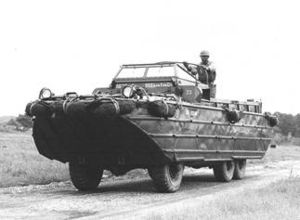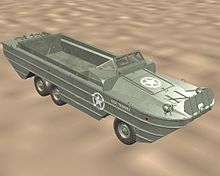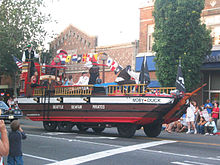- DUKW
-
DUKW 
A DUKW, in use by American troops in France.Type amphibious transport Place of origin  United States
United StatesProduction history Manufacturer GMC Number built 21,147[1][2] Specifications Weight 6.5 short tons (5.9 t) empty[3] Length 31 ft (9.4 m)[3] Width 8 ft 27/8 in (2.5 m)[3] Height 7 ft 1.375 in (2.17 m) without ring mount[3] Crew 1[3] Main
armamentring mount for machine gun fitted to 25% built[3] Engine GMC 6-cylinder 269 cid
94 hp[3]Power/weight 14 hp/tonne Payload capacity 2.5 short tons (2.3 t)[4] or 12 troops Suspension wheels, 6×6 Operational
range400 mi (640 km) at 35 mph (56 km/h) on road,
50 nmi (93 km; 58 mi) on water[3]
Speed 50 mph (80 km/h) on road,
5.5 kn (10.2 km/h; 6.3 mph) on water[3]
The DUKW (colloquially known as duck) is a six-wheel-drive amphibious truck that was designed by a partnership under military auspices of Sparkman & Stephens and General Motors Corporation (GMC) during World War II for transporting goods and troops over land and water and for use approaching and crossing beaches in amphibious attacks. Designed to last only long enough to meet the demands of combat, productionized Ducks, a modification of the 2-ton capacity "deuce" trucks used by the US military in World War II, were later used as tourist craft in marine environments.
Contents
Designation
The designation of DUKW is not a military acronym; rather, the name comes from the model naming terminology used by GMC:[5]
- "D" indicated a vehicle designed in 1942,
- "U" meant "utility",
- "K" indicated front-wheel drive,
- "W" indicated two powered rear axles.
Decades later, the DUKW designation was explained erroneously by writers such as Donald Clarke who wrote in 1978 that it was an acronym for "Duplex Universal Karrier, Wheeled".[6] This mistaken explanation is likely a backronym fabricated by someone unaware of GMC naming practice.
Description
The DUKW was designed by Rod Stephens Jr. of Sparkman & Stephens Inc. yacht designers, Dennis Puleston, a British deep water sailor resident in the US, and Frank W. Speir, a Reserve Officers' Training Corps Lieutenant out of MIT.[7] Developed by the National Defense Research Committee and the Office of Scientific Research and Development, it was initially rejected by the armed services. When a United States Coast Guard patrol craft ran aground on a sandbar near Provincetown, Massachusetts, an experimental DUKW happened to be in the area for a demonstration. Winds up to 60 knots (110 km/h), rain, and heavy surf prevented conventional craft from rescuing the seven stranded Coast Guardsmen, but the DUKW had no trouble, and the military opposition melted. The DUKW would later prove its seaworthiness by crossing the English Channel.
The DUKW prototype was built around the GMC ACKWX, a cab-over-engine (COE) version of the GMC CCKW six-wheel-drive military truck, with the addition of a watertight hull and a propeller. The final production design, perfected by a few engineers at Yellow Truck & Coach in Pontiac Michigan, was based on the CCKW. The vehicle was built by the GMC division of General Motors (which was still called Yellow Truck and Coach at the beginning of the war). It was powered by a GMC Straight-6 engine of 270 in³ (4.416 L). The DUKW weighed 6.5 tons empty and operated at 50 miles per hour (80 km/h) on road and 5.5 knots (10.2 km/h; 6.3 mph) on water.[3] It was 31 feet (9.4 m) long, 8 feet 2.875 inches (2.51 m) wide, 7 feet 1.375 inches (2.17 m) high with the folding-canvas top down[3] and 8.8 feet (2.6 m) high with the top up. 21,137 were manufactured.[1] It was not an armored vehicle, being plated with sheet steel between 1/16 and 1/8 inches (1.6–3.2 mm) thick to minimize weight. A high capacity bilge pump system kept the DUKW afloat if the thin hull was breached by holes up to 2 inches (51 mm) in diameter. One of every four vehicles were produced with a ring mount for machine gun,[3] which would usually have held a .50-caliber (12.7 mm) Browning heavy machine gun.[8]
The DUKW was the first vehicle to allow the driver to vary the tire pressure from inside the cab, an accomplishment of Speir's device. The tires could be fully inflated for hard surfaces such as roads and less inflated for softer surfaces—especially beach sand. This added to the DUKW's great versatility as an amphibious vehicle. This feature is now standard on many military vehicles.
The DUKW's windshields were provided by GM rival Libbey Glass (Ford) under the "Defense Plant Corporation" umbrella as a result of Henry Gassaway, one of the GM engineers whose wife's family worked for Libby, and whose test driving broke the first windshields.[9]
Service history
The DUKW was supplied to the US Army, US Marine Corps and Allied forces. 2,000 were supplied to Britain under the Lend-Lease program[10] and 535 were acquired by Australian forces.[11] 586 were supplied to the Soviet Union, and they would build their own version post war: the BAV 485 (see Developments).
The DUKW was used in landings in the Mediterranean, Pacific, on the D-Day beaches of Operation Husky, Normandy, but also during the Battle of the Scheldt, Operation Veritable and Operation Plunder. Its principal use was to ferry supplies from ship to shore, but it was used for other tasks, such as transporting wounded combatants to hospital ships or operations in flooded (polder) landscape.[citation needed]
After World War II, reduced numbers of DUKWs were kept in service by the United States, Britain, France and Australia with many more stored pending disposal. Australia transferred many to Citizens Military Force units.
The US Army reactivated and deployed several hundred DUKWs at the outbreak of the Korean War with the 1st Transportation Replacement Training Group providing crew training. DUKWs were used extensively to bring supplies ashore during the Battle of Pusan Perimeter and in the amphibious landings at Inchon.
Ex-US Army DUKWs were transferred to the French military after World War II and were used by the Troupes de marine and naval commandos. Many were used for general utility duties in overseas territories. France deployed DUKWs to French Indochina during the First Indochina War. Some French DUKWs were given new hulls in the 1970s with the last being retired in 1982.
Britain deployed DUKWs to Malaya during the Malayan Emergency of 1948–60. Many were redeployed to Borneo during the Indonesia–Malaysia confrontation of 1962–66.
The Royal Marines still use four of these vehicles for training purposes at 11 (Amphibious Trials and Training) Squadron, 1 Assault Group Royal Marines at Instow North Devon. The DUKWs are used for safety to allow the training of all ranks to undertake drills for boat work for the landing craft ranks and the drivers undertaking wading drills from the LCU (Landing Craft Utility.[citation needed]
Principal military users
 Australia – 535[11]
Australia – 535[11] Canada – approximately 800
Canada – approximately 800 France -
France - Soviet Union – 586
Soviet Union – 586 United Kingdom – approximately 2,000
United Kingdom – approximately 2,000 United States -
United States -
Peacetime use
Although DUKWs were used predominantly for the military, many were used by civilian organizations such as police departments, fire stations and rescue units.
The Australian Army lent two DUKWs and crew to Australian National Antarctic Research Expeditions in 1948 for an expedition to Macquarie Island. Australian DUKWs were used on Antarctic supply voyages until 1970.[11] From 1945 to 1965, the Australian Commonwealth Lighthouse Service supply ship Cape York carried ex-Army DUKWs for supplying lighthouses on remote islands.[12]
Several were used by abalone fishermen of San Luis Obispo County California to take their catch right off the boats and directly to market, neatly combining the two steps of off-loading onto smaller craft, and then transferring to trucks once they reached the beach.
Whenever a natural disaster or an emergency situation occurs, DUKWs are well equipped for the land and water rescue efforts. Australian Army Reserve DUKWs were used extensively for rescue and transport during the 1955 Hunter Valley floods.
One of the last DUKWs manufactured in 1945 was loaned to a fire department during the Great Flood of 1993, and in 2005, Duck Riders of Grapevine, TX deployed the vehicle to help in the aftermath of Hurricane Katrina. The DUKW was well equipped to maneuver its way through flood waters, transporting victims stranded on their rooftops to helicopter pads set up throughout New Orleans.
Some such as the "Moby Duck" have been adapted as props by local groups such as Seattle's Seafair Pirates to be used in parades and events.
One DUKW is in use by the THW of Germersheim in Germany ("Technisches Hilfswerk", a public organization supplying technical support).[13]
Developments
In the latter 1940s and throughout the 1950s, while Speir, now Project Engineer for the Army's Amphibious Warfare Program, worked on "bigger and better" amphibious vehicles such as the "Super Duck", the "Drake" and the mammoth BARC (Barge, Amphibious, Resupply, Cargo), a good many DUKWs were made surplus and put to use as amphibious rescue vehicles by fire departments and even, coming full circle, by Coast Guard stations.
In 1952 the USSR produced a derivative of the DUKW adding a rear loading ramp – the Zavod imeni Stalina factory built the BAV 485 on the structure of their ZiS-151 truck. Production continued until 1962 with over 2,000 units delivered.
Tourist attraction
DUKWs are still in use, as well as purpose-built amphibious tour buses, primarily as tourist transport in harbor and river cities. The first "duck tour" company was started in 1946 by Mel Flath in Wisconsin Dells, Wisconsin. The company is still in operation under the name Original Wisconsin Ducks.[14]
DUKWs in fiction
Two DUKWs, Gert and Daisy (named after radio music-hall artistes Elsie and Doris Waters), are central to Ron Dawson's novel, The Last Viking: The Untold Story of the World's Greatest Heist. The novel tells the story of a modern day Viking raid by a group of Birmingham gangsters who capture and loot the island of Guernsey on the tenth anniversary of D Day with disastrous consequences. The novel is probably unique in featuring two DUKWs in a post-World War II adventure.[15]
A DUKW was prominently featured in the ending sequence of the 1987 film Revenge of the Nerds II: Nerds in Paradise.
A DUKW is also central to the 2000 AD story Disaster 1990, in which the lead character, London hardman Bill Savage, liberates one from a war museum to survive a futuristic flooded Britain.
Images
-
DUKW at the U.S. Army Transportation Museum
See also
- Ford GPA and GAZ 46 - 4 wheel amphibious jeeps
- Landwasserschlepper
- PTS
- Terrapin (amphibious vehicle) – a contemporary British equivalent vehicle
- LARC-V
- Landing Vehicle Tracked - tracked supply and combat amphibious vehicle
- List of U.S. military vehicles by supply catalog designation
Notes
- ^ a b "DUKW". US Army Transportation Museum. Archived from the original on 2008-07-25. http://web.archive.org/web/20080725043610/http://www.transchool.eustis.army.mil/Museum/DUKW.htm.
- ^ Bishop, Chris (2002). The Encyclopedia of Weapons of WWII. Sterling Publishing Company. p. 67. ISBN 1586637622. http://books.google.com/?id=MuGsf0psjvcC&pg=PA67. Retrieved 2010-03-24.
- ^ a b c d e f g h i j k l Friedman, Norman (2002). U.S. amphibious ships and craft: an illustrated design history. Illustrated Design Histories. Naval Institute Press. p. 218. ISBN 1557502501. http://books.google.com/?id=oWX-x0b4pw4C&pg=PA218&lpg=PA218. Retrieved March 22, 2010.
- ^ Thomson, Harry C. (2003). The Ordnance Department : procurement and supply. Washington, D.C: Center of Military History, U.S. Army. p. 284. http://www.archive.org/stream/ordnancedepartme00thom#page/284/mode/1up. Retrieved 2009-10-20.
- ^ Michigan manufacturer and financial record. 73. Manufacturer Publishing Co.. 1944. p. 104. "The first letter represents the model year. In this case it was "D" which was the letter for 1942. The second letter in the combination designates the basic type of vehicle and for the amphibian truck is "U"—meaning utility. The third letter, "K", is the letter given to GMC vehicles which have front wheel drive while the fourth letter, "W", shows that the vehicle has six-wheel dual-driving axles. The code resulted in the combination "DUKW" which quickly and aptly became the nickname "Duck" to the men in the factory and in the Armed Forces alike.""
- ^ Clarke, Donald (1978). How it works: the illustrated encyclopedia of science and technology. 1. Marshall Cavendish. p. 96.
- ^ Miami Shipbuilding Corporation
- ^ Fitzsimons, Bernard, general editor. The Illustrated Encyclopedia of 20th Century Weapons and Warfare (London: Phoebus, 1978), Vol. 8, p.802, "DUKW".
- ^ Berndt collection, Birmingham Historical Museum & Park (MI)
- ^ "Battle Stations II: The 'Duck'". Channel 4. http://www.channel4.com/history/microsites/H/history/a-b/battletwo03.html.
- ^ a b c "Remember when.... we sent amphibious trucks to the Antarctic?". Defence Materiel Organisation. November 2006. http://www.defence.gov.au/dmo/news/ontarget/nov06/rw.cfm. Retrieved 2008-10-13.
- ^ Johnson, Erika (2006), Cape Rochon – An Island Light, 9, Lighthouses of Australia Bulletin
- ^ Orstverband Gemersheim
- ^ Original Wisconsin Ducks: Ducks Celebrate 65 Years
- ^ The Last Viking
References
- Technical Manuals[clarification needed]
-
- TM 9-2800 military vehicles 1947
- SNL G501
- TM 9-802
- TM 9-1825A
- TM 9-1826C
- TM 9-1827B
- TM 9-1827C
- TM 9-1828A
- TM 9-1829A
- TM 9-1802A Ordnance Maintenance Power Plant for 2½-Ton Truck 6 x 6 (GMC). United States Department of War. July 1943.
- TM 9-1802B Ordnance Maintenance Power Plant for 2½-Ton Amphibian Truck, 6 x 6 (GMC DUKW-353). United States Department of War. November 1943.
- TM 9-1802C Ordnance Maintenance Hull and Water Drive for 2½-Ton 6 x 6 Amphibian Truck, (GMC DUKW-353). United States Department of War. December 1943.
External links
- US Army Transportation Museum DUKW page, with photos
- Marine Corps DUKWs in World War II
- Sparkman & Stephens : the company at which Rod Stephens Jr., one of the DUKW's designer, worked (see also this photo with explanatory caption, on the S&S site)
- Lace and DUKWs... both part of the Speir Family legacy, several photos, statistics, and a few details of Speir's tire inflation system from his son Dean Speir
- DUKW: its operation and uses.
American armored fighting vehicles of World War IILight tanks M1 Combat Car · M2 Light Tank · M3/M5 Light Tank · M22 Light Tank · M24 Light Tank · Marmon-Herrington CTLSMedium / heavy tanks Self-propelled artillery Tank destroyers M3 Gun Motor Carriage · M6 Gun Motor Carriage · M10 3-inch Gun Motor Carriage · M18 Gun Motor Carriage · M36 Gun Motor CarriageArmored half-tracks Amphibious vehicles Armored cars Experimental vehicles M38 Wolfhound · T1/M6 Heavy Tank · T28 Tank/T95 GMC · Assault Tank T14 · Heavy Tank T29 · Heavy Tank T30 · Medium Tank T20 · T16 · T3 Half Track · T27 Armored Car
T54 Gun Motor Carriage · T40/M9 Tank Destroyer · T19 Howitzer Motor Carriage · 8in Howitzer Motor Carriage T84 · T92 Howitzer Motor Carriage · T55E1 Motor Carriage · Light Tank T7/Medium Tank M7 · T88 Gun Motor CarriageCategories:- GMC vehicles
- Amphibious military vehicles
- Soft-skinned vehicles
- Landing craft
- World War II military vehicles
- World War II vehicles of Australia
- World War II vehicles of the United States
- Motor vehicles manufactured in the United States
- Wheeled amphibious vehicles
Wikimedia Foundation. 2010.







